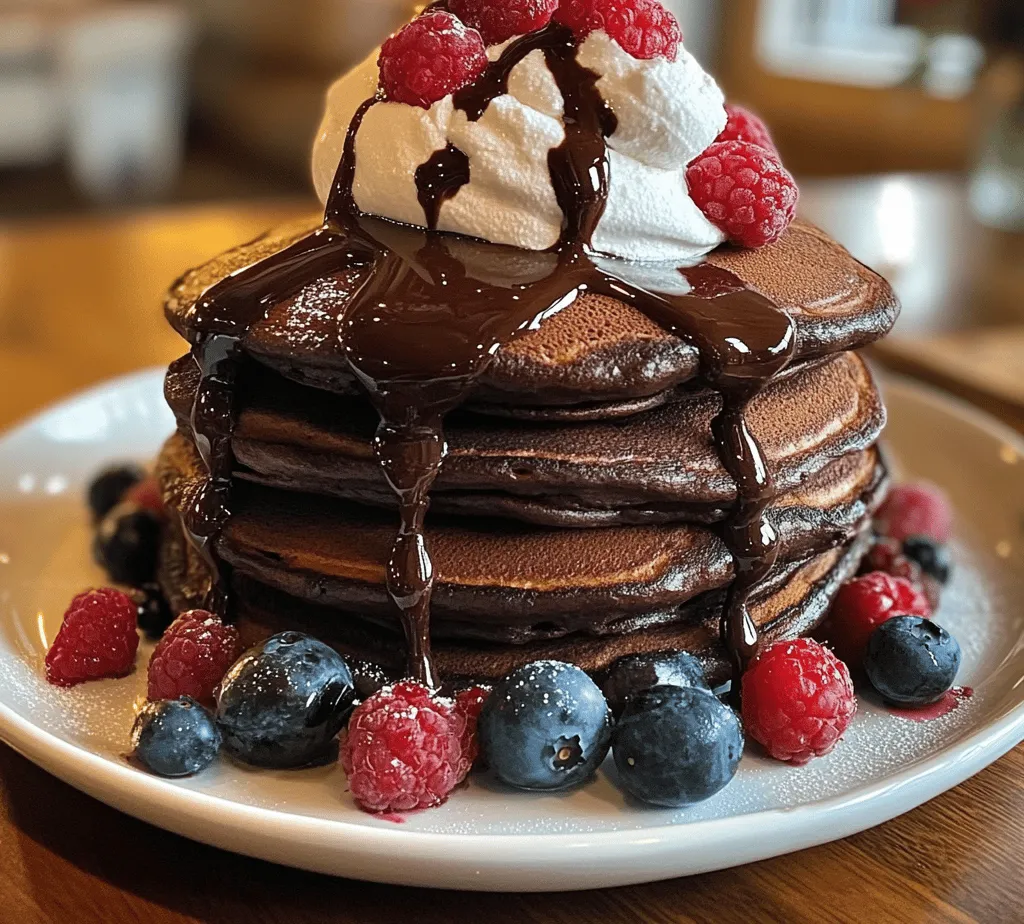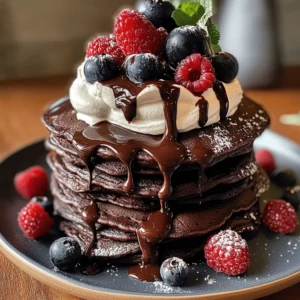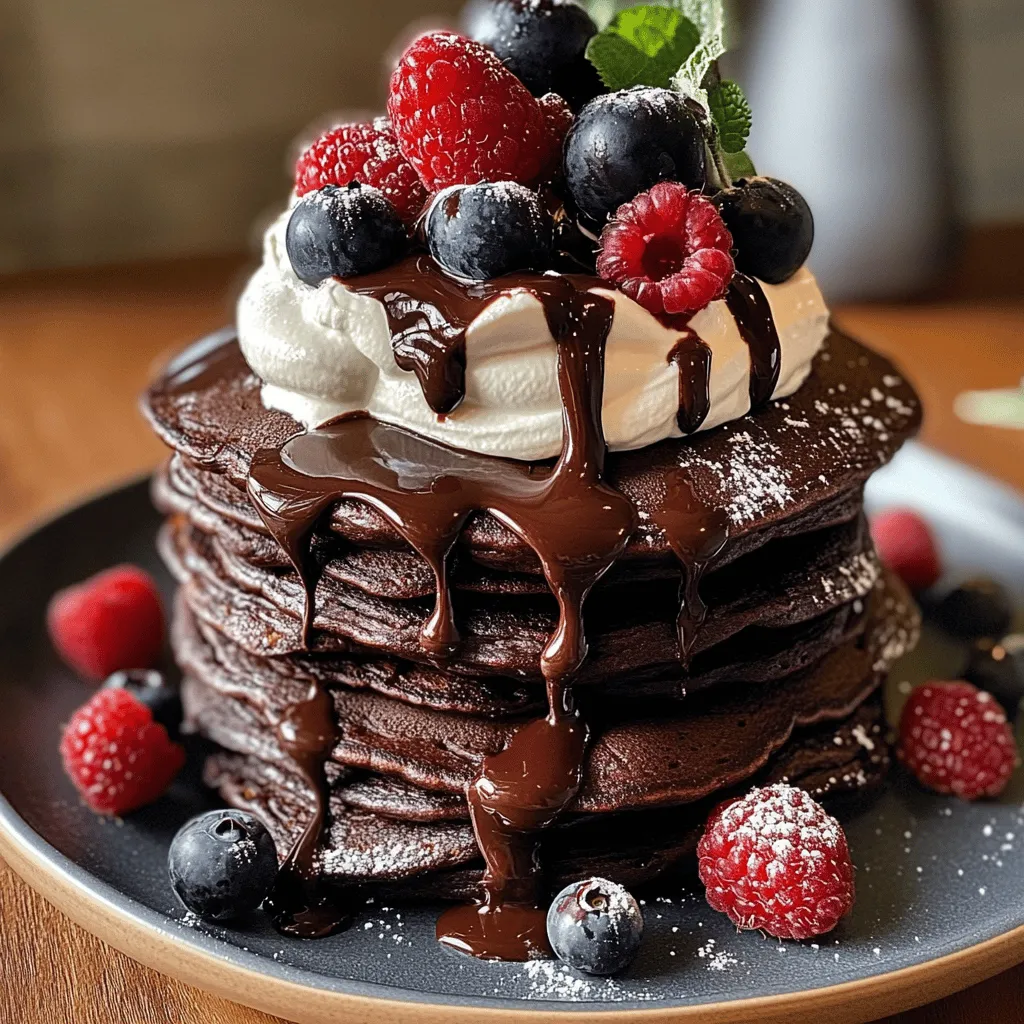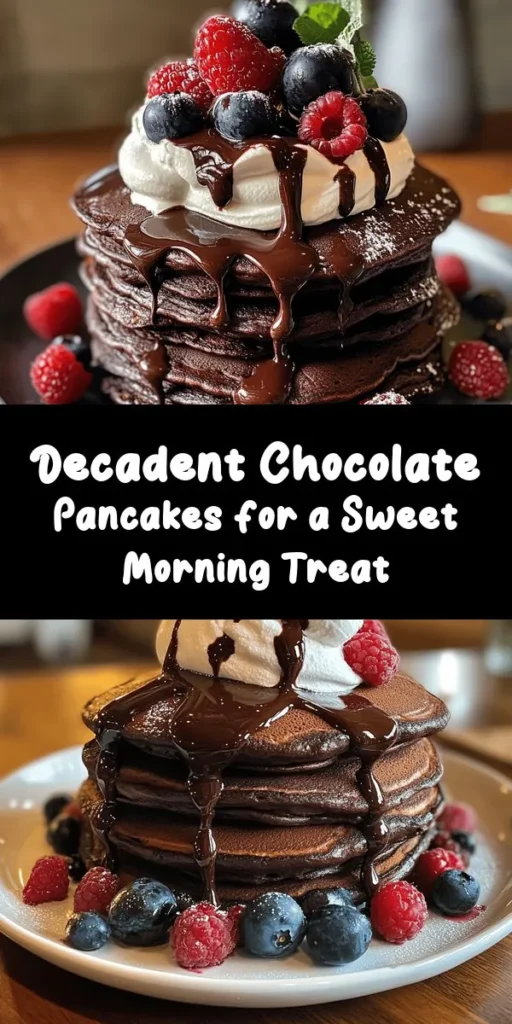Introduction
Chocolate pancakes have become a beloved breakfast treat for many, transcending the boundaries of age and culinary experience. What could be better than waking up to the aroma of freshly cooked pancakes infused with rich cocoa, promising a delightful start to your day? The mere thought of sinking your fork into a stack of fluffy, chocolatey goodness drizzled with syrup or adorned with fresh fruit can make anyone’s mouth water. These pancakes not only cater to the sweet tooth but also provide a comforting indulgence that can elevate breakfast from mundane to extraordinary.
In this blog post, we will guide you through a recipe that promises to deliver the most amazing chocolate pancakes you’ve ever tasted. With the perfect balance of cocoa richness and a light, airy texture, these pancakes are designed to impress not just your palate but also your friends and family. Whether you’re preparing a leisurely weekend breakfast or looking to surprise someone special, this recipe is sure to become a staple in your kitchen.
Understanding the Ingredients
To create the most amazing chocolate pancakes, it’s essential to understand the role of each ingredient in the recipe. Each component contributes not just flavor but also texture, moisture, and overall structure to the pancakes. Let’s dive deeper into the key ingredients that make this recipe a success.
All-Purpose Flour
All-purpose flour is the foundation of pancake batter, providing the necessary structure for these delicious treats. The gluten content in all-purpose flour helps create a stable pancake that can rise and hold its shape during cooking. When sifting or mixing the flour, it’s important to aerate it to avoid lumps and ensure an even distribution in the batter. For optimal results, consider using a kitchen scale to measure the flour accurately, as too much flour can lead to dense pancakes.
Cocoa Powder
Cocoa powder is the star of the show in this recipe, imparting the rich chocolate flavor that makes these pancakes so irresistible. When choosing cocoa powder, opt for high-quality unsweetened cocoa for a deeper, more complex flavor. Dutch-processed cocoa can also be used for a milder taste and darker color. The cocoa powder not only adds flavor but also contributes to the overall look of the pancakes, giving them that enticing chocolatey hue.
Sugars
In our chocolate pancake recipe, both granulated sugar and brown sugar play crucial roles. Granulated sugar enhances sweetness while providing a subtle crunch when the pancakes are cooked. Brown sugar, on the other hand, adds moisture and a hint of caramel flavor due to its molasses content. This combination of sugars not only sweetens the pancakes but also helps create a beautiful golden-brown crust, enhancing the overall texture.
Leavening Agents
Leavening agents, specifically baking powder and baking soda, are vital for achieving the light and fluffy texture characteristic of great pancakes. Baking powder is a double-acting leavening agent that releases carbon dioxide gas both when mixed with wet ingredients and when heated, resulting in a fluffy pancake. Baking soda, which requires an acidic ingredient to activate, complements the baking powder and contributes to the lift. Together, these leavening agents ensure that your chocolate pancakes rise perfectly, giving them that desirable height and softness.
Milk and Oil
Milk adds moisture to the batter, creating a creamy consistency that helps the pancakes cook evenly. The fat in the milk also contributes to a tender pancake. You can use whole milk for a richer flavor or low-fat alternatives if you’re looking for a lighter option. Oil, typically vegetable oil or melted butter, enhances the richness of the batter while preventing the pancakes from sticking to the pan. The combination of milk and oil creates a beautifully smooth batter that translates into fluffy, decadent pancakes.
Eggs and Vanilla Extract
Eggs serve as a binding agent in pancake batter, helping to hold the ingredients together while also providing structure. They add richness and moisture, contributing to the overall flavor and texture of the pancakes. Vanilla extract is a flavor enhancer that brings warmth to the dish, rounding out the chocolate flavor and making each bite more delightful. A splash of vanilla elevates the pancakes from simple to sensational, creating a well-rounded breakfast experience.
Chocolate Chips
For those who crave an extra chocolatey experience, chocolate chips are an optional yet highly recommended addition. As the pancakes cook, the chocolate chips melt slightly, creating pockets of gooey chocolate that make each bite even more indulgent. You can choose semi-sweet, dark, or even white chocolate chips depending on your preference. Just be sure to fold them into the batter gently to prevent them from sinking to the bottom.
Toppings
The right toppings can elevate your chocolate pancakes to new heights. Popular options include fresh berries, whipped cream, and a drizzle of maple syrup. You might also consider adding a sprinkle of powdered sugar for a touch of elegance or a dollop of nut butter for added protein and flavor. The beauty of chocolate pancakes is their versatility; feel free to get creative with your toppings to personalize your breakfast experience.
Step-by-Step Instructions to Create the Most Amazing Chocolate Pancakes
Now that we’ve covered the essential ingredients, let’s dive into the step-by-step instructions to create the most amazing chocolate pancakes. Follow these guidelines carefully to ensure your pancakes turn out perfectly every time.
Mixing the Dry Ingredients
Start by gathering all your dry ingredients: all-purpose flour, cocoa powder, granulated sugar, brown sugar, baking powder, baking soda, and a pinch of salt. In a large mixing bowl, sift together the flour and cocoa powder to eliminate any lumps and ensure even distribution. Sifting also aerates the mixture, which is key to achieving fluffy pancakes.
Next, add the granulated sugar, brown sugar, baking powder, baking soda, and salt to the bowl. Whisk the dry ingredients together thoroughly until they are well combined. This is an important step; even distribution of the leavening agents and sugars will result in uniform cooking and flavor throughout your pancakes.
Combining the Wet Ingredients
In a separate bowl, combine all your wet ingredients: milk, oil, eggs, and vanilla extract. Whisk them together until the mixture is smooth and well-blended. This step is crucial because it ensures that the eggs are fully incorporated, which will help with the binding and texture of the pancakes.
If you prefer a richer flavor, you can use melted butter instead of oil. Just make sure the butter is slightly cooled before adding it to avoid cooking the eggs. You can also experiment with different milk alternatives, such as almond milk or oat milk, for a unique twist on the flavor.
Combining Wet and Dry Ingredients
At this stage, it’s time to bring your wet and dry mixtures together. Make a well in the center of the dry ingredients and pour in the wet mixture. Using a spatula or wooden spoon, gently fold the ingredients together. Be careful not to overmix; it’s okay if there are a few small lumps in the batter. Overmixing can lead to tough pancakes, as it develops the gluten in the flour too much.
If you are adding chocolate chips, this is the time to fold them in gently. Aim to incorporate them evenly throughout the batter without crushing them. Once combined, let the batter rest for about 5-10 minutes. This resting period allows the flour to hydrate and the leavening agents to activate, resulting in even fluffier pancakes when cooked.
Stay tuned for the next part where we’ll cover the cooking process and additional tips for achieving pancake perfection!

Preparing the Pan
Achieving the perfect cooking surface is crucial for making the most amazing chocolate pancakes. Start by selecting a non-stick skillet or griddle, which will help prevent the pancakes from sticking and allow for easy flipping. Before you begin cooking, preheat your pan over medium heat for about 5 minutes. This ensures an even cooking temperature throughout the pancakes.
To further enhance the non-stick properties of your pan, lightly grease it with a small amount of butter or cooking spray. Avoid over-greasing, as too much fat can lead to greasy pancakes. Instead, use a paper towel to spread a thin layer of butter or oil evenly across the surface. A well-prepared pan will help you achieve the ideal golden-brown crust while keeping the insides soft and fluffy.
Cooking the Pancakes
Once your pan is prepped and heated, it’s time to cook the pancakes. Pour about 1/4 cup of batter onto the skillet for each pancake. You can adjust the amount based on your desired pancake size, but keeping them uniform ensures even cooking. Allow the batter to spread naturally—this will form a nice, round pancake.
Cook the pancakes for about 2-3 minutes on the first side. You’ll know it’s time to flip them when you see bubbles forming on the surface and the edges starting to look set. Carefully flip the pancake using a spatula, ensuring you do so gently to avoid splattering hot batter. Cook for an additional 1-2 minutes on the other side until golden brown and cooked through. Repeat the process for the remaining batter, adjusting the heat as necessary to prevent burning. If you find the pancakes browning too quickly, lower the heat slightly.
Serving Suggestions
Presentation can elevate your pancake experience to a whole new level. Stack your chocolate pancakes neatly on a plate, and consider adding a variety of toppings for visual appeal and flavor enhancement. Here are some creative serving suggestions:
1. Chocolate Sauce Drizzle: Warm some chocolate sauce and drizzle it generously over the stack for an indulgent touch.
2. Fresh Fruits: Add a medley of fresh berries, sliced bananas, or even caramelized apples for a burst of color and natural sweetness.
3. Whipped Cream: A dollop of whipped cream on top adds a light, airy texture that complements the dense chocolate flavor.
4. Nuts and Seeds: Sprinkle chopped nuts, such as pecans or walnuts, or seeds like chia or hemp for added crunch and nutrition.
5. Maple Syrup: Serve with a side of pure maple syrup for a classic touch, allowing diners to pour as desired.
6. Ice Cream: For a decadent twist, serve pancakes with a scoop of vanilla or chocolate ice cream, making it a delightful dessert option.
The Science Behind Perfect Pancakes
Understanding the science behind pancake-making can help you achieve the best results every time.
Understanding Batter Consistency
The consistency of your batter plays a significant role in the texture of your pancakes. A thicker batter will generally yield thicker pancakes, which can be desirable for a fluffy texture. However, if the batter is too thick, it won’t spread easily on the pan, leading to uneven cooking. Aim for a batter that is pourable but still holds its shape when dropped. Adjust the consistency by adding a little more milk if it’s too thick or a bit of flour if it’s too runny.
The Role of Heat in Cooking
Heat is another crucial factor in pancake cooking. If your skillet is too hot, the outside of the pancake may burn while the inside remains uncooked. Conversely, cooking at too low a temperature can lead to dry pancakes. The ideal cooking temperature is medium to medium-low, allowing the pancakes to rise and fluff up as they cook. As they heat, the baking powder activates, producing gas bubbles that give pancakes their light and airy quality.
Serving Temperature
Pancakes are best enjoyed warm. Serving them immediately after cooking helps retain their fluffy texture and enhances the overall experience. If you’re preparing a large batch, consider keeping the finished pancakes warm in a low oven (around 200°F) while you finish cooking the rest. This ensures that everyone gets to enjoy their pancakes at the perfect temperature.
Healthier Alternatives and Modifications
For those looking to modify the recipe for dietary preferences or health reasons, there are several alternatives to consider.
Gluten-Free Options
If you or someone you are serving is gluten-sensitive, you can easily make gluten-free chocolate pancakes by substituting all-purpose flour with a gluten-free flour blend. Brands like Bob’s Red Mill or King Arthur Flour provide great options that can be used in equal amounts as a direct replacement for regular flour.
Dairy-Free Variations
To make the recipe dairy-free, opt for non-dairy milk alternatives such as almond milk, soy milk, or oat milk. These substitutes work well without compromising the flavor or texture of the pancakes. Additionally, consider using dairy-free butter or coconut oil for greasing the pan.
Sugar Substitutes
If you want to reduce sugar intake while maintaining flavor, there are various sugar substitutes available. Options include stevia, monk fruit sweetener, or coconut sugar, which can provide sweetness without the calories of traditional sugar. Adjust the quantity based on the substitute you choose, as some may be sweeter than regular sugar.
Cultural Significance of Pancakes
Pancakes have a rich cultural significance around the world, with each region boasting its unique take on this beloved breakfast dish.
Pancakes Around the World
From crepes in France to dosa in India, pancakes come in many forms globally. In the United States, fluffy, thick pancakes are a breakfast staple, often served with syrup and butter. In contrast, French crepes are thin and delicate, typically filled with sweet or savory fillings. Japanese soufflé pancakes are known for their airy, cloud-like texture. Each variation offers a glimpse into the culinary traditions and preferences of different cultures.
Chocolate Pancakes in Different Cuisines
Chocolate pancakes have made their mark in various cuisines as well. For instance, in Germany, you might find chocolate pancakes served as dessert, filled with sweet cream cheese or fruit. In Brazil, chocolate is often incorporated into a rich batter for their fluffy panquecas. Exploring these variations can inspire new ways to enjoy chocolate pancakes in your kitchen.
Conclusion
Making and enjoying the most amazing chocolate pancakes is a delightful experience that can easily become a cherished breakfast tradition. The process of creating these fluffy, chocolatey stacks brings warmth and joy to any morning. Whether you stick to the classic recipe or opt for healthier alternatives, the versatility of pancakes allows for endless experimentation.
Encouraging creativity with toppings and presentation not only enhances the visual appeal but also allows for a personalized touch. As you perfect your pancake-making skills, you’ll find that this simple recipe can transform into a beloved family favorite. So gather your ingredients, heat up that skillet, and indulge in a delicious breakfast that promises to satisfy. Happy cooking!



